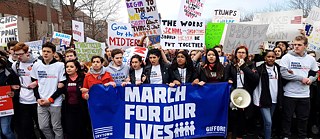Activism
March for Our Lives in Boston

After the last mass school shooting in Parkland, FL where 17 students were killed the students of Marjory Stoneman Douglas High School created a movement.
The students gave interviews, held speeches, met with politicians, and organized the nation-wide MARCH FOR OUR LIVES. On Saturday, March 24, Boston students, parents, and teachers joined hundreds of thousands of others all over the world to end gun violence. Boston Police officials said over 50,000 joined the march from Madison Park High School in Roxbury to the rally at Boston Common.
I’m running late. There is no public transportation to Madison Park High School from my home so I decided to walk. I see the first people with signs at the Museum of Fine Arts. The closer I get the more people are streaming down the side walks and at some point down the streets. At Roxbury Crossing it becomes clear that I won’t make it all the way to Madison Park, where the march will be kicking off at 11am, since Malcolm X Boulevard is already overflowing with people. That’s when I hear them for the first time. The chanting, the screaming is deafening. I imagined that this would be a very emotional day, but I wasn’t prepared for the full force of it. I hurry to catch a glimpse of the front line, a picture of the specific moment at which this movement starts here in Boston. And I’m hit by their demands of “Not one more!” “Show me what democracy looks like. This is what democracy looks like.” “Not in our streets, not in our schools.” thrown out into the cameras in front of them, the streets of Roxbury, and the world as a whole.
Next to student organizers like Michael Martinez and other local Roxbury students there are also Leonor Muñoz, a Stoneman Douglas survivor and her sister Beca, a Northeastern University student, walking and shouting up front. Later on they will join teachers and other students on the stage in Boston Common for an emotional speech, but right now they’re marching arm in arm, supporting each other – pressing house and senate for change.
I join the ranks and get swept up in the energy of the march, the signs, the fear, but also the community. When the crowd moves on to Columbus Avenue it is impossible to see the end of it. There are only rows and rows of people swinging signs saying: “Am I Next?”; “Arms are for hugging”; “Enough is Enough”; “Never Again”; “The time is now”. When I reach Boston Common, the number of marches becomes overwhelming. The park fills up in minutes, people are everywhere. Organizers make sure students get the best positions close to the stage that is set up near the Charles & Beacon Streets entrance of the park.
I make my way up the hill to the Soldiers and Sailors Monument to get a better look of the crowd. At the top I climb on one of the stone benches already occupied by a group of older women holding signs saying “Granny’s against gun violence”. And I am blown away by the amount of people gathering on the green space in the heart of the city. The hum in the air of their voices sounds like a swarm of angry bees. Far away I hear Graciela Mohamedi, a teacher at Rockland High School and a former US marine, asking the people in power to “Arm us with books that aren’t missing pages. But don’t arm us with guns.” To better understand the speakers on stage I try to get closer, not an easy task. I make a left at the Boston Common Carousel when Leonor Muñoz and her sister Beca enter the stage holding hands. “I remember the absolute terror of being outside hearing: CODE RED, RUN!” Leonor Muñoz cries out, her voice trembling. “These are our lives at stake.” she continues. “We shouldn’t have to fight for our lives.” Beca Muñoz follows up. And together they finish with: “But we will and we are!” The crowd is cheering, the sound of 50,000 people raising their voices together to “Not one more! Not one more! Not one more!” is rocking the earth at Boston Common.
When I leave the Common at the exit at Spruce Street the first flakes of snow begin tumbling down. The crowd slowly begins to disperse into the streets around the park. Parents with tired kids in strollers and on their arms are making their way home. What’s left of this exciting day is to hope that the conversation will continue and things actually will change.